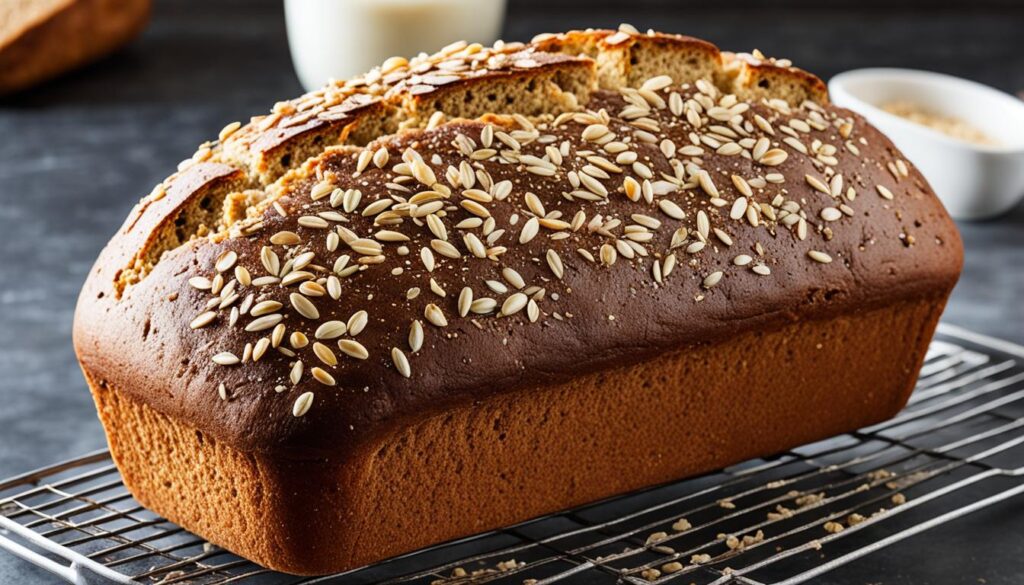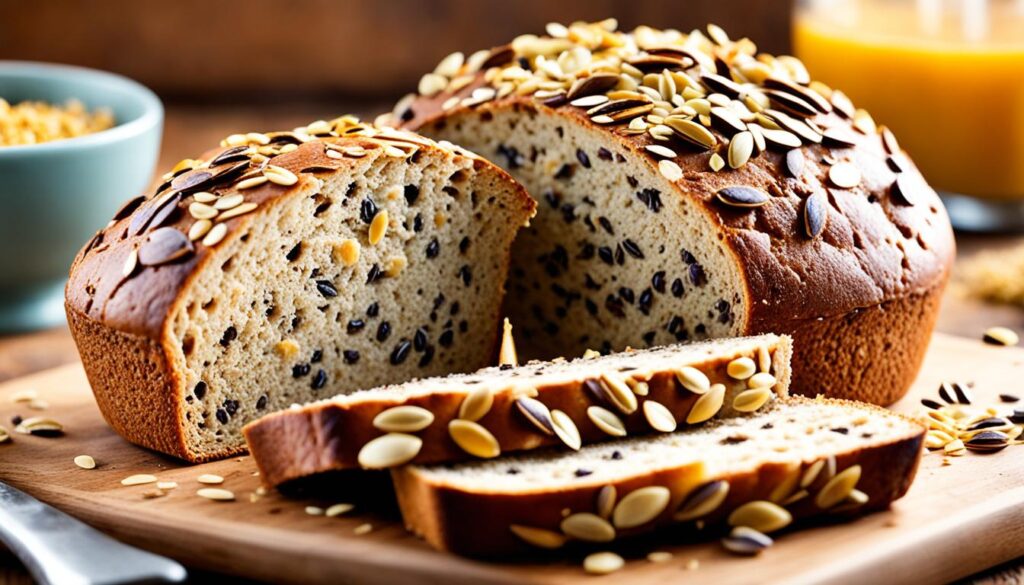Are you looking for a healthy bread option that is both nutritious and delicious? Look no further than multi grain bread! This homemade bread is made with a blend of multigrain hot cereal mix or whole oats, giving it a slightly nutty and earthy flavor. Not only does it taste great, but it also offers a range of health benefits.
Made with a combination of bread flour and whole wheat flour, multi grain bread is packed with fiber, vitamins, and minerals. The inclusion of seeds and nuts adds extra texture and boosts the nutritional profile of this bread. Whether you’re making sandwiches or enjoying it with your favorite spreads, multi grain bread is a wholesome choice for any meal.
Key Takeaways:
- Multi grain bread is a homemade bread made with a blend of multigrain hot cereal mix or whole oats.
- It has a nutty and earthy flavor, with a soft and fluffy texture.
- The ingredients include multigrain cereal mix or oats, boiling water, brown sugar, butter, bread flour, and whole wheat flour.
- Optional add-ins like seeds and nuts can be included for added texture.
- Multi grain bread is perfect for sandwiches, toast, or enjoying on its own.
Homemade Multigrain Bread: A Perfectly Soft and Sturdy Loaf
This homemade multigrain bread recipe is a delightful twist on traditional white sandwich bread. The secret to achieving a soft and sturdy loaf lies in the careful combination and balance of ingredients.
The dough for this bread is made by soaking multigrain cereal mix or oats in boiling water, which helps to release their flavors and textures. Brown sugar is added for a touch of sweetness, while butter contributes to a soft and tender texture.
The key to the multigrain aspect of the bread is a blend of bread flour and whole wheat flour. These flours work together to create a well-structured loaf with a wholesome taste. Additionally, the inclusion of seeds and nuts adds a delightful crunch and extra depth to the bread.
After the dough has been mixed and kneaded, it is left to rise until doubled in size. This fermentation process allows the yeast to release carbon dioxide, resulting in a light and airy texture. The dough is then shaped into a loaf and placed in the oven to bake until golden brown.

Once baked, you’ll be greeted with a beautifully golden crust and a soft yet sturdy interior, making this bread perfect for sandwiches, toast, and a variety of other uses.
Experiment with different fillings, spreads, or toppings to create the ultimate sandwich experience. From classic favorites to gourmet combinations, this homemade multigrain bread provides a versatile canvas for your culinary creativity.
Now that you know the secrets of creating a perfectly soft and sturdy loaf, it’s time to roll up your sleeves and embark on a baking adventure. Prepare your ingredients, follow the recipe, and soon you’ll be enjoying the wholesome goodness of your very own homemade multigrain bread.
Stay tuned for the next section where we’ll share some valuable tips and tricks for making your homemade multigrain bread journey even more enjoyable and successful!
How to Make Homemade Multigrain Bread: Tips and Tricks for Success
Making homemade multigrain bread requires attention to detail and a few tips and tricks for success. If you’re new to bread-making, it’s recommended to read the directions thoroughly before starting and review guides on baking with yeast and kneading dough. These resources can provide valuable insights and help you feel more confident in the process.
The dough for homemade multigrain bread involves an extra step of soaking the grains in boiling water. To ensure the yeast activates properly, it’s important to let the mixture cool to the right temperature before adding it. This step will help create the ideal environment for the yeast to thrive and contribute to a well-risen loaf.
When selecting flour for your multigrain bread, using bread flour instead of all-purpose flour can result in a sturdier and more bread-like texture. Bread flour has a higher protein content, which contributes to better gluten development and a chewier crumb. To achieve the best results, try to incorporate bread flour into your recipe.
Optional add-ins like seeds and nuts can enhance the flavor and texture of your multigrain bread. However, it’s best to add them after the first proofing of the dough. This will prevent the ingredients from inhibiting the yeast’s activity during the initial rise. Adding these elements at the right time will ensure they are evenly distributed throughout the bread.
The proofing time of the dough can vary depending on the temperature and humidity of your kitchen. It’s important to monitor the dough and follow the specified times in your recipe. The ideal proofing conditions will allow the yeast to ferment and produce the desired rise and texture in your bread.
Lastly, it’s crucial to use fresh yeast and ensure it is within its expiration date. Using expired or inactive yeast can result in a dense and unappetizing loaf. Checking the expiration date and using fresh yeast will give your bread the best chance to rise and develop those beautiful air pockets.
Follow these tips and tricks to achieve success with your homemade multigrain bread. With attention to detail and the right techniques, you’ll be able to enjoy a wholesome and delicious loaf that will impress your family and friends.
Tips for Making Homemade Multigrain Bread:
- Read the directions thoroughly and review guides on bread-making with yeast.
- Soak the grains in boiling water and let the mixture cool before adding yeast.
- Opt for bread flour instead of all-purpose flour for a sturdier texture.
- Add seeds and nuts after the first proofing of the dough.
- Monitor the proofing time according to the temperature and humidity of your kitchen.
- Use fresh yeast within its expiration date.
Additional Advice on Bread-making:
“Bread-making is an art that requires patience and practice. Don’t be discouraged if your first attempt doesn’t turn out perfectly. Each batch of dough is a learning experience, and with time, you’ll master the art of homemade multigrain bread.” – Renowned Baker
Now that you have a solid understanding of the tips and tricks for making homemade multigrain bread, you’re ready to move on to the next section, where we’ll explore fun variations and uses for this wholesome bread.
| Tips and Tricks for Homemade Multigrain Bread |
|---|
| Read the directions thoroughly |
| Review bread-making guides |
| Soak grains before adding yeast |
| Use bread flour for a sturdier texture |
| Add seeds and nuts after the first proofing |
| Monitor proofing time based on kitchen conditions |
| Use fresh yeast within its expiration date |
Variations and Uses for Homemade Multigrain Bread
While this recipe is specifically for a homemade multigrain sandwich bread, there are various variations and uses for homemade multigrain bread. Let your culinary creativity shine by exploring different ways to enjoy this nutritious and flavorful bread.
Variations of Homemade Multigrain Bread
Homemade multigrain bread provides a versatile canvas for experimentation. Consider these variations to add unique flavors and textures:
- Add different types of seeds like sesame, flax, or sunflower seeds for a crunchy bite.
- Include a mix of nuts such as almonds, walnuts, or pecans to enhance the bread’s richness.
- For a touch of sweetness, incorporate raisins or dried cranberries into the dough.
- Combine a variety of ingredients for a multigrain bread bursting with flavors and textures, like a blend of sunflower seeds, pumpkin seeds, and dried apricots.
Uses for Multigrain Bread
Once you have baked your homemade multigrain bread, there are numerous delicious ways to enjoy it:
- Make mouthwatering sandwiches using your favorite fillings like sliced turkey, lettuce, and tomatoes. The nutty flavor of the bread will complement the fresh ingredients perfectly.
- Have a toasted slice of multigrain bread with a spread of your choice, such as avocado, almond butter, or cream cheese. It’s a satisfying and nutritious option for breakfast or a snack.
- Pair your homemade multigrain bread with a warm bowl of soup or a refreshing salad. The hearty texture and nutty flavor will elevate your meal.
Artisan Multigrain Bread
If you’re feeling adventurous, use your homemade multigrain bread as a base for creating artisan-style loaves or rolls. With decorative cuts and a golden brown crust, artisan multigrain bread adds an elegant touch to any meal. Follow traditional bread shaping techniques or let your imagination run wild in creating unique designs.
Remember, homemade multigrain bread is not only a nutritious option but also an opportunity to unleash your creativity in the kitchen. Explore different variations and savor the delicious uses of this versatile bread.

| Variation | Description |
|---|---|
| Seeded Multigrain Bread | This variation incorporates a mix of sesame, flax, and sunflower seeds for added crunch and flavor. |
| Nutty Multigrain Bread | Featuring a combination of almonds, walnuts, and pecans, this variation adds richness and depth to the bread. |
| Harvest Multigrain Bread | A delightful blend of raisins, dried cranberries, and pumpkin seeds creates a sweet and savory combination. |
| Apricot Multigrain Bread | This variation combines sunflower seeds, pumpkin seeds, and dried apricots for a burst of flavors and textures. |
Conclusion
Homemade multigrain bread is a wholesome and nutritious option for those looking to incorporate more fiber into their diet. This delicious loaf, with its soft and fluffy texture and slightly nutty flavor, is the perfect choice for sandwiches, toast, or enjoying on its own. The addition of seeds and nuts provides extra texture and a boost of healthy fats.
The process of making homemade multigrain bread may require a bit more effort and attention to detail, but the end result is a rewarding and satisfying loaf. By following the steps outlined in this article and using quality ingredients like multigrain cereal mix and bread flour, you can create a loaf that rivals the ones found in bakeries.
So why not embark on a bread-making adventure and try making your own homemade multigrain bread? Not only will you have the satisfaction of creating a delicious and wholesome loaf, but you’ll also enjoy the benefits of knowing exactly what goes into your bread. Treat yourself and your family to the goodness of homemade multigrain bread, and savor each wholesome bite.
FAQ
What is multi grain bread?
Multi grain bread is a homemade soft bread made with a blend of multigrain hot cereal mix or whole oats. It has a slightly nutty and earthy flavor, with a soft and fluffy texture.
What are the ingredients for multi grain bread?
The ingredients for this bread include multigrain cereal mix or oats, boiling water, brown sugar, butter, and a combination of bread flour and whole wheat flour. Optional add-ins like seeds and nuts can be included for added texture.
How long does it take to make multi grain bread?
The entire process takes about 4-5 hours, including the time for soaking the grains, kneading the dough, and allowing it to rise.
Can I use all-purpose flour instead of bread flour?
It is recommended to use bread flour instead of all-purpose flour for a sturdier and more bread-like texture.
Are there variations and uses for multi grain bread?
Yes, the dough can be used to make multigrain rolls, and other variations include adding different types of seeds, nuts, raisins, dried cranberries, or a blend of these ingredients. Multi grain bread is perfect for sandwiches, toasting, and serving as a side with soups or salads.